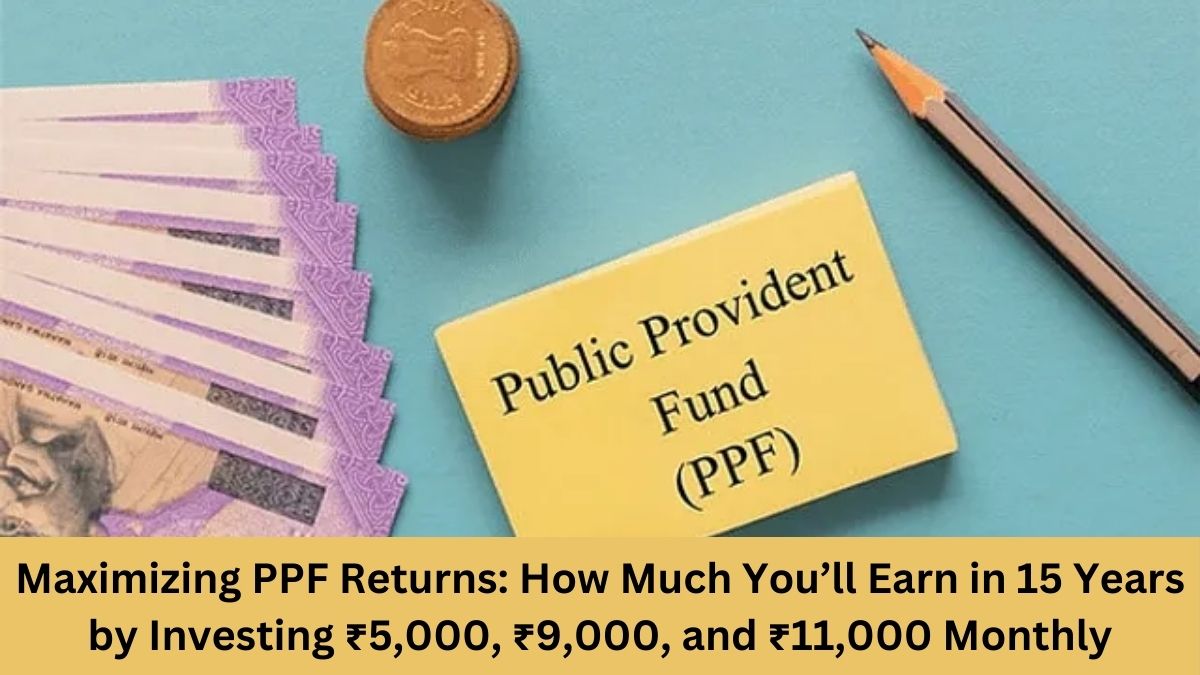The Public Provident Fund (PPF) is a long-term, government-backed investment scheme known for its low-risk and tax-free returns. Falling under the Exempt-Exempt-Exempt (EEE) category, it offers tax exemptions on deposits, interest earned, and withdrawals, making it a highly attractive option for conservative investors seeking steady growth.
For those planning consistent monthly investments, it’s essential to understand how much wealth can be accumulated over 15 years. This guide will break down the estimated returns for different monthly investments and provide insights into various aspects of PPF.

Opening a PPF Account: Post Office vs. Bank
You can open a PPF account at either a Post Office or a Bank, with both options providing the same benefits and regulations. The choice often depends on personal convenience and accessibility.
Who Can Open a PPF Account?
Eligibility for opening a PPF account includes:
- Resident Indian Adults: Any individual residing in India can open a PPF account in their own name.
- Guardians for Minors or Incapacitated Persons: Parents or legal guardians can open accounts on behalf of minors or those who cannot operate their accounts.
✅ Important Note: An individual can hold only one PPF account across the country, whether in a bank or a post office.
PPF Deposit Rules and Limits
The PPF scheme has clear guidelines regarding the minimum and maximum deposits allowed within a financial year.
| Criteria | Minimum Deposit | Maximum Deposit |
|---|---|---|
| Annual Deposit | ₹500 | ₹1.5 lakh |
| Combined Deposit Limit | ₹1.5 lakh | Applies to personal accounts and accounts opened on behalf of minors. |
Investors can make deposits in lump sums or installments, but the total contributions in a financial year must not exceed ₹1.5 lakh.
PPF Account Maturity and Extension Options
The maturity period for a PPF account is 15 financial years, excluding the financial year of opening. After this period, investors have the following options:
-
Withdraw Full Amount:
Submit the account closure form along with the passbook to the post office or bank. -
Retain Maturity Value Without Further Deposits:
Continue to earn interest at the prevailing rate without making additional contributions. -
Extend the Account in Blocks of 5 Years:
Investors can extend the account indefinitely in blocks of five years by submitting a prescribed extension form within one year of maturity. This option is particularly beneficial for those looking to continue growing their corpus without tax implications.
PPF Account Withdrawal Rules
While PPF is a long-term investment, partial withdrawals are allowed under certain conditions:
-
Timing of Withdrawal:
Withdrawals can be made only after completing five years from the date of account opening, excluding the year of opening. -
Withdrawal Limit:
The maximum withdrawal amount is 50% of the balance at the end of the fourth preceding year or the previous year, whichever is lower.
These withdrawal rules provide flexibility for investors needing partial access to their funds while maintaining the overall investment’s growth potential.
PPF Calculation: Estimating Returns Over 15 Years
The PPF account offers a fixed annualized interest rate of 7.1%. Let’s explore how much you can earn with different monthly investments over a 15-year period.
| Monthly Investment | Annual Investment | Total Investment (15 years) | Estimated Interest Earned | Estimated Maturity Amount |
|---|---|---|---|---|
| ₹5,000 | ₹60,000 | ₹9,00,000 | ₹7,27,284 | ₹16,27,284 |
| ₹9,000 | ₹1,08,000 | ₹16,20,000 | ₹13,09,111 | ₹29,29,111 |
| ₹11,000 | ₹1,32,000 | ₹19,80,000 | ₹16,00,024 | ₹35,80,024 |
The calculations above clearly show the power of consistent investing in PPF. Even modest monthly contributions can grow significantly over 15 years due to the compounding effect.
What to Do After PPF Maturity
Upon maturity, investors can choose to:
- Withdraw the entire amount by filling out a closure form.
- Continue earning interest on the accumulated corpus without further deposits.
- Extend the account for another block of 5 years and continue to enjoy tax-free returns.
The decision to extend or withdraw should depend on the investor’s financial goals, ongoing liquidity needs, and alternative investment options.
Why Choose PPF as an Investment Option?
The PPF scheme is ideal for individuals seeking:
-
Safety of Capital:
Being government-backed, the scheme provides complete security of invested capital. -
Tax Benefits:
Enjoying EEE status, PPF investments are tax-free at all stages—deposit, growth, and withdrawal. -
Guaranteed Returns:
Despite market fluctuations, PPF offers a fixed interest rate determined by the government quarterly.
Frequently Asked Questions
Q1: Can NRI investors open a PPF account?
No, only resident Indian citizens are eligible to open a PPF account. However, NRIs can continue existing accounts opened before their change of residential status until maturity.
Q2: Is there a penalty for not investing every year?
Yes, a penalty of ₹50 per year is levied for failing to contribute the minimum annual amount of ₹500. Additionally, the account will be considered inactive until the penalty is cleared.
Q3: Can I take a loan against my PPF account?
Yes, loans can be taken from the 3rd to the 6th financial year against the balance in your PPF account. The maximum loan amount is capped at 25% of the balance at the end of the second preceding year.
Q4: How is the interest calculated on a PPF account?
Interest is compounded annually but calculated monthly based on the lowest balance between the 5th and the last day of the month.
Q5: What happens if I exceed the ₹1.5 lakh deposit limit?
Any excess amount deposited beyond the limit will not earn interest and cannot be claimed for tax benefits under Section 80C.
This comprehensive guide to Public Provident Fund (PPF) highlights how consistent monthly investments can generate substantial returns over 15 years. Understanding the rules, eligibility, and investment calculations can help investors make informed decisions about their financial future.
Click here to know more.
Kishan is a knowledgeable writer specializing in agriculture and the latest government job recruitments, delivering clear and insightful content to inform and empower readers.
